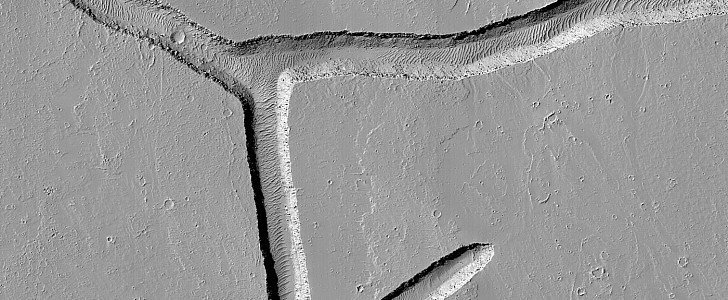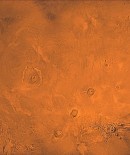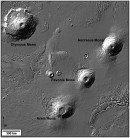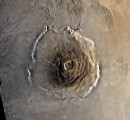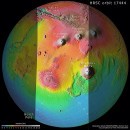There is an old saying by famed Catalan architect Antonio Gaudi that goes something like “there are no straight lines in nature.” While that may be true here on Earth, there’s no saying what we’ll uncover in the big strange Universe we’re inhabiting. And you don’t have to look past Mars to know that is so.
The neighboring planet has been under surveillance for decades now and, even if we can’t say we know all there is to know about the place, we sure do have a greater deal of understanding now than we had say two or three decades ago.
But that doesn’t mean Mars can’t surprise us anymore. And with several pieces of hardware on the surface, looking into things, and a few others in orbit, surveying places of the planet, the potential for surprise is always great.
What you’re looking at here are officially called by NASA and the University of Arizona “intersecting troughs, or fractures, cut across geologically young volcanic terrain in the Tharsis volcanic province.“ From these fractures, material erupted sometime in the planet’s past, and created what may seem to an untrained eye as Japanese writing on the surface of the planet (click main photo for full view).
And although they’re not exactly made of straight lines, they come close enough to put Gaudi’s statement into question.
The image was captured in June 2021 by the HiRISE camera of the Mars Reconnaissance Orbiter from an altitude of 274 km (170 miles), and it shows something scientists cannot fully explain.
We’re told these fractures, don’t seem to be the result of material erupting from them, as it happens all over the region. Instead, these particular ones “appear to crosscut material that flowed across the surface, indicating that the fractures are younger than the flows.”
Scientists here on Earth use these kind of images to get a better understanding of the "processes happening in Mars’ interior."
But that doesn’t mean Mars can’t surprise us anymore. And with several pieces of hardware on the surface, looking into things, and a few others in orbit, surveying places of the planet, the potential for surprise is always great.
What you’re looking at here are officially called by NASA and the University of Arizona “intersecting troughs, or fractures, cut across geologically young volcanic terrain in the Tharsis volcanic province.“ From these fractures, material erupted sometime in the planet’s past, and created what may seem to an untrained eye as Japanese writing on the surface of the planet (click main photo for full view).
And although they’re not exactly made of straight lines, they come close enough to put Gaudi’s statement into question.
The image was captured in June 2021 by the HiRISE camera of the Mars Reconnaissance Orbiter from an altitude of 274 km (170 miles), and it shows something scientists cannot fully explain.
We’re told these fractures, don’t seem to be the result of material erupting from them, as it happens all over the region. Instead, these particular ones “appear to crosscut material that flowed across the surface, indicating that the fractures are younger than the flows.”
Scientists here on Earth use these kind of images to get a better understanding of the "processes happening in Mars’ interior."
